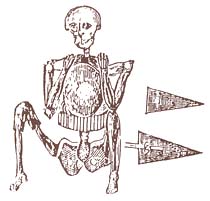
In 1832, a human skeleton was unearthed in a sandbank in Fall River, Mass. A triangular plate of brass covered its sternum, and it wore a broad belt of brass tubes. The grave also contained a number of brass and copper arrowheads. To judge from the skull, the skeleton had belonged to a young man, but from where? The local Indian tribes did not work brass.
One commentator claimed it as evidence that the Phoenicians, Carthaginians, or Egyptians had discovered North America in the remote past. Later historians speculated that an early Norse explorer might have traveled south from Newfoundland, but the style of armor was unknown to medieval Norway. A third possibility is that it belonged to an early European colonist, perhaps a Portuguese explorer.
The skeleton was destroyed in a fire in 1843, so there’s no way now to date the remains scientifically, or to gather any further information. Its identity must remain a mystery.
